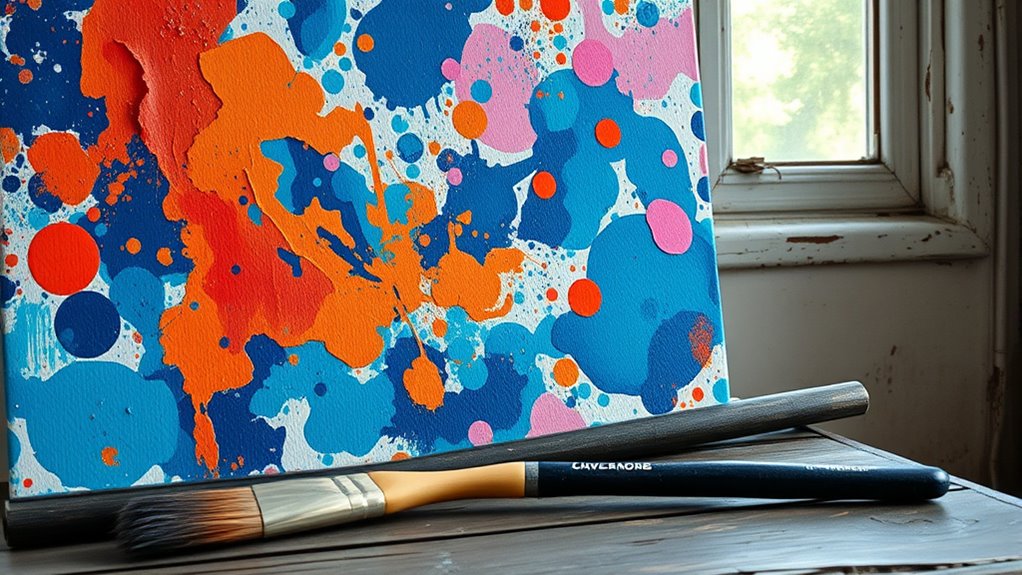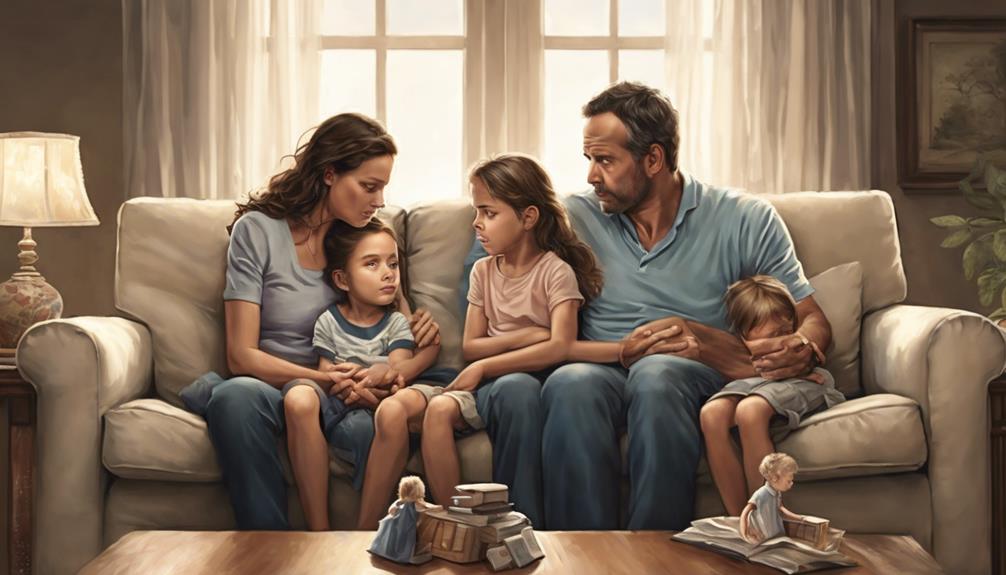Using art therapy helps you process tough divorce emotions by providing a safe space to express feelings beyond words. Creating art allows you to channel intense emotions like sadness, anger, and frustration into visual forms, making them easier to understand and release. It also encourages mindfulness, helping you stay grounded and reduce stress. By engaging regularly, you’ll develop healthier coping skills and gain clarity. Keep exploring ways to heal through creative expression—there’s more to discover about this empowering approach.
Key Takeaways
- Art therapy provides a safe outlet to express complex feelings related to divorce beyond verbal communication.
- Creating art helps channel and release intense emotions like sadness, anger, and frustration associated with divorce.
- Engaging in artistic activities fosters mindfulness, reducing anxiety and promoting emotional regulation during difficult times.
- Artistic expression offers distraction from ruminative thoughts, building resilience and healthier coping strategies.
- Regular art practice supports ongoing healing, clarity, and personal growth throughout the divorce process.

Going through a divorce can stir up intense emotions that feel overwhelming or hard to express with words alone. During this challenging time, finding healthy ways to cope becomes essential. Art therapy offers a powerful approach to help you process these feelings by providing alternative coping strategies that go beyond verbal communication. Instead of bottling up your emotions or feeling stuck in endless thoughts, engaging in creative activities allows you to channel your inner experiences into visual forms. This process encourages emotional expression in a safe, non-judgmental space, helping you gain clarity and relief.
Art therapy helps process overwhelming divorce emotions through creative expression and safe, non-judgmental exploration.
When emotions run high, it’s common to feel overwhelmed or disconnected from your feelings. Art therapy invites you to explore these complex emotions through drawing, painting, or even sculpting, which can bypass the barriers that words sometimes create. As you put your feelings onto paper or into a sculpture, you give shape and form to what might seem unmanageable internally. This act of creating becomes a form of emotional release, helping you confront and understand your inner landscape more clearly. Rather than suppressing pain or anger, you learn to express them constructively, reducing their intensity and making them easier to manage.
Using art as a form of emotional expression also fosters mindfulness. As you focus on colors, shapes, and textures, you become more present in the moment, which can be incredibly grounding. This focused attention helps diminish feelings of anxiety or despair, giving you space to process your divorce-related feelings gradually. It’s important to remember that there’s no “right” or “wrong” way to create; the goal isn’t to produce perfect artwork but to use art as a tool for self-discovery and healing.
In addition to emotional expression, art therapy provides a distraction from ruminative thoughts and offers a constructive outlet for frustration or sadness. When you’re immersed in creating, your mind shifts away from distressing scenarios, giving you a mental break and a chance to reset emotionally. Over time, this can build resilience, helping you develop more adaptive coping strategies for managing ongoing stress or grief associated with divorce.
Engaging in art therapy can also enhance your awareness of emotional regulation skills, helping you manage intense feelings more effectively. Ultimately, engaging in art therapy allows you to process your divorce emotions in a deeply personal way. It empowers you to explore feelings that might be difficult to articulate verbally, fostering emotional growth and healing. Through consistent creative practice, you’ll find new ways to cope, express, and move forward with a renewed sense of understanding and strength.
Frequently Asked Questions
Can Children Benefit From Art Therapy During Divorce?
Yes, children can benefit from art therapy during divorce. It encourages child engagement and provides a safe space for emotional expression, helping them process feelings they might not have words for. Through creative activities, you can see their inner struggles and support their healing. Art therapy helps children feel understood and empowered, reducing stress and fostering resilience during difficult times.
How Does Art Therapy Differ From Traditional Talk Therapy?
Art therapy differs from traditional talk therapy by emphasizing creative expression for emotional processing. Instead of solely talking about feelings, you use art to explore and communicate complex emotions that might be hard to put into words. This approach allows you to access deeper insights, unbolt subconscious thoughts, and process your feelings more freely. It’s a powerful way to connect with your emotions through visual and tactile experiences, fostering healing and self-awareness.
Are There Specific Art Techniques Recommended for Divorce-Related Emotions?
You should try visual journaling and expressive drawing to process divorce-related emotions. These techniques help you achieve emotional release by externalizing feelings onto paper, making them easier to understand and release. Juxtapose vibrant colors with darker shades to reflect mixed emotions. Engaging in these art forms allows you to explore your inner world, gain clarity, and foster healing, turning overwhelming feelings into tangible, manageable expressions.
How Long Does It Typically Take to See Progress With Art Therapy?
You can usually see emotional progress within a few sessions, but the therapy timeline varies based on individual needs. Some people notice significant changes after 4 to 6 sessions, while others may take longer. Consistency and openness are key. Keep in mind, art therapy isn’t about quick fixes; it’s a process that helps you understand and manage your divorce emotions more effectively over time.
Is Art Therapy Effective for Ongoing Co-Parenting Challenges?
Yes, art therapy can be effective for ongoing co-parenting challenges. It helps you improve coparenting communication by allowing you to express feelings visually, fostering understanding. Additionally, it builds emotional resilience as you process complex emotions creatively. Through regular sessions, you gain tools to navigate conflicts calmly, strengthen your relationship with your ex-partner, and support your child’s well-being—all essential for smoother co-parenting.
Conclusion
You might find that engaging in art therapy helps you process divorce emotions more effectively than you expected. Research suggests that creative expression can activate neural pathways associated with emotional regulation, supporting the idea that art therapy isn’t just about making art—it’s about healing. By channeling your feelings into art, you could tap into a subconscious layer of resilience, confirming the theory that creative outlets foster emotional recovery and personal growth during challenging times.










